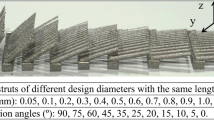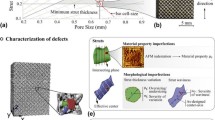Abstract
Synchrotron radiation X-ray micro-computed tomography (SR-µCT) is a 3D imaging technique that is widely employed for the characterization of defects in advanced materials and structures. In this study, we characterize several typical defects in octettruss and re-entrant 3D lattice structures by using SR-µCT. The 3D micro-lattice structures are manufactured using projection micro litho stereo exposure (PµLSE) additive manufacturing technology. The as-fabricated 3D lattice samples are characterized using optical microscopy, and subsequently, by SR-µCT. Further more, a statistical analysis is performed to characterize the surface roughness and internal defects qualitatively, whereby the statistical geometrical parameters of struts along different directions and strut joints are analyzed and classified. Consequently, several typical defects are identified: (1) holes at the joints of the strut and irregular diameter deviations of the strut in the octet-truss lattice structure; (2) irregular diameter variations, bulges, dislocations, grooves, accumulations, and torsion in the re-entrant lattice structure. All of these defects are related to the building direction, the weight of the structure, bubbles, dust, and impurities during the PµLSE additive manufacturing process.
Similar content being viewed by others
References
Wu W, Hu W, Qian G, et al. Mechanical design and multifunctional applications of chiral mechanical metamaterials: A review. Mater Des, 2019, 180: 107950
Xiao D, Dong Z, Li Y, et al. Compression behavior of the graded metallic auxetic reentrant honeycomb: Experiment and finite element analysis. Mater Sci Eng-A, 2019, 758: 163–171
Wu W, Song X, Liang J, et al. Mechanical properties of anti-tetrachiral auxetic stents. Composite Struct, 2018, 185: 381–392
Bhargav A, Sanjairaj V, Rosa V, et al. Applications of additive manufacturing in dentistry: A review. J Biomed Mater Res, 2018, 106: 2058–2064
Camposeo A, Persano L, Farsari M, et al. Additive manufacturing: Applications and directions in photonics and optoelectronics. Adv Opt Mater, 2019, 7: 1800419
Kim T B, Yue S, Zhang Z, et al. Additive manufactured porous titanium structures: Through-process quantification of pore and strut networks. J Mater Processing Tech, 2014, 214: 2706–2715
Kerckhofs G, Pyka G, Moesen M, et al. High-resolution microfocus X-ray computed tomography for 3D surface roughness measurements of additive manufactured porous materials. Adv Eng Mater, 2013, 15: 153–158
Song J, Gao L, Cao K, et al. Metal-coated hybrid meso-lattice composites and their mechanical characterizations. Composite Struct, 2018, 203: 750–763
Scarlett N V Y, Tyson P, Fraser D, et al. Synchrotron X-ray CT characterization of titanium parts fabricated by additive manufacturing. Part I. Morphology. J Synchrotron Rad, 2016, 23: 1006–1014
Scarlett N V Y, Tyson P, Fraser D, et al. Synchrotron X-ray CT characterization of titanium parts fabricated by additive manufacturing. Part II. Defects. J Synchrotron Rad, 2016, 23: 1015–1023
Uesugi M, Uesugi K, Takeuchi A, et al. Three-dimensional observation of carbonaceous chondrites by synchrotron radiation X-ray CT— Quantitative analysis and developments for the future sample return missions. GeoChim CosmoChim Acta, 2013, 116: 17–32
Fan X, He X, Nutor R K, et al. Effect of stress on crystallization behavior in a Fe-based amorphous ribbon: An in situ synchrotron radiation X-ray diffraction study. J Magn Magn Mater, 2019, 469: 349–353
Liu L, Kamm P, García-Moreno F, et al. Elastic and failure response of imperfect three-dimensional metallic lattices: The role of geometric defects induced by Selective Laser Melting. J Mech Phys Solids, 2017, 107: 160–184
Hu Y N, Wu S C, Song Z, et al. Effect of microstructural features on the failure behavior of hybrid laser welded AA7020. Fatigue Fract Eng Mater Struct, 2018, 41: 2010–2023
Wu S C, Hu Y N, Duan H, et al. On the fatigue performance of laser hybrid welded high Zn 7000 alloys for next generation railway components. Int J Fatigue, 2016, 91: 1–10
Wu S C, Xiao T Q, Withers P J. The imaging of failure in structural materials by synchrotron radiation X-ray microtomography. Eng Fract Mech, 2017, 182: 127–156
Wu Q, Vaziri A, Asl M E, et al. Lattice materials with pyramidal hierarchy: Systematic analysis and three dimensional failure mechanism maps. J Mech Phys Solids, 2019, 125: 112–144
Xu Y, Zhang H, Šavija B, et al. Deformation and fracture of 3D printed disordered lattice materials: Experiments and modeling. Mater Design, 2019, 162: 143–153
Carlton H D, Lind J, Messner M C, et al. Mapping local deformation behavior in single cell metal lattice structures. Acta Mater, 2017, 129: 239–250
Deshpande V S, Fleck N A, Ashby M F. Effective properties of the octet-truss lattice material. J Mech Phys Solids, 2001, 49: 1747–1769
Chen X Y, Tan H F. An effective length model for octet lattice. Int J Mech Sci, 2018, 140: 279–287
Wang X T, Wang B, Li X W, et al. Mechanical properties of 3D reentrant auxetic cellular structures. Int J Mech Sci, 2017, 131–132: 396–407
Geng L, Wu W, Sun L, et al. Damage characterizations and simulation of selective laser melting fabricated 3D re-entrant lattices based on in situ CT testing and geometric reconstruction. Int J Mech Sci, 2019, 157–158: 231–242
Author information
Authors and Affiliations
Corresponding authors
Additional information
This work was supported by the National Natural Science Foundation of China (Grant Nos. 11702023, 11632010, 11972081), the Graduate Technological Innovation Project of Beijing Institute of Technology (Grant No. 2019CX20049). The authors would like to thank the BMF Precision Technology Co, Ltd. for supporting the micro/nano-scale 3D printing work.
Rights and permissions
About this article
Cite this article
Hu, W., Liu, L., Wu, W. et al. Micro and nanolattice fabrication using projection micro litho stereo exposure additive manufacturing techniques and synchrotron X-ray 3D imaging-based defect characterization. Sci. China Technol. Sci. 63, 561–570 (2020). https://doi.org/10.1007/s11431-019-1453-4
Received:
Accepted:
Published:
Issue Date:
DOI: https://doi.org/10.1007/s11431-019-1453-4




